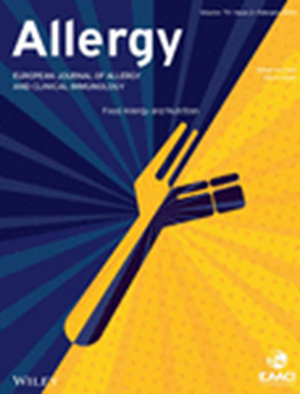Phytic Acid Improves the Skin Barrier Function in Murine Models of Atopic Dermatitis Through Skin Microbiota‐Derived Indole‐3‐Propionic Acid
IF 12.6
1区 医学
Q1 ALLERGY
引用次数: 0
Abstract
BackgroundBarrier dysfunction and dysbiosis of the skin microbiota are two of the key factors in the pathogenesis of atopic dermatitis (AD). Phytic acid (PA) is a common constituent of high‐fiber foods, whereas its role in AD remains unelucidated. The aim of this study was to investigate the effects of PA‐altered skin microbial metabolites on AD and to explore its specific mechanism.MethodsMC903‐induced AD mouse models were used to explore the role of PA on AD by TEWL, immunofluorescence, and qPCR analysis. Using cohouse experiments with feces removal to verify the role of skin microbiota. The specific mechanism of effect of PA was explored through 16S, RNA‐seq, LC–MS/MS, luciferase assay, and in vivo experiments with siRNA.ResultsDiet‐derived PA significantly improved the barrier function of MC903‐induced AD, whether administered by gavage or topically. Topical application of PA reshaped the skin microbiota in AD mice and increased tryptophan‐metabolizing bacteria, especially植酸通过皮肤微生物群衍生的吲哚- 3 -丙酸改善小鼠特应性皮炎模型的皮肤屏障功能
背景:屏障功能障碍和皮肤微生物群失调是特应性皮炎(AD)发病的两个关键因素。植酸(PA)是高纤维食物的常见成分,但其在AD中的作用尚不清楚。本研究的目的是研究PA改变皮肤微生物代谢物对AD的影响,并探讨其具体机制。方法利用smc903诱导的AD小鼠模型,通过TEWL、免疫荧光和qPCR分析,探讨PA对AD的作用。采用粪便清除实验验证皮肤微生物群的作用。通过16S、RNA‐seq、LC-MS /MS、荧光素酶测定和siRNA体内实验,探讨了PA的具体作用机制。结果无论是灌胃还是局部给药,饮食来源的PA均能显著改善MC903诱导AD的屏障功能。局部应用PA重塑了AD小鼠的皮肤微生物群,增加了色氨酸代谢细菌,特别是表皮葡萄球菌。此外,PA上调皮肤微生物群衍生的吲哚衍生物,特别是吲哚- 3 -丙酸(IPA),从而激活AHR,促进KRT10的转录,从而进一步改善AD。我们的研究结果表明,饮食来源的PA通过改变皮肤微生物来源的代谢物来改善AD的屏障功能,这表明PA是治疗AD的一种新的治疗策略。
本文章由计算机程序翻译,如有差异,请以英文原文为准。
求助全文
约1分钟内获得全文
求助全文
来源期刊

Allergy
医学-过敏
CiteScore
26.10
自引率
9.70%
发文量
393
审稿时长
2 months
期刊介绍:
Allergy is an international and multidisciplinary journal that aims to advance, impact, and communicate all aspects of the discipline of Allergy/Immunology. It publishes original articles, reviews, position papers, guidelines, editorials, news and commentaries, letters to the editors, and correspondences. The journal accepts articles based on their scientific merit and quality.
Allergy seeks to maintain contact between basic and clinical Allergy/Immunology and encourages contributions from contributors and readers from all countries. In addition to its publication, Allergy also provides abstracting and indexing information. Some of the databases that include Allergy abstracts are Abstracts on Hygiene & Communicable Disease, Academic Search Alumni Edition, AgBiotech News & Information, AGRICOLA Database, Biological Abstracts, PubMed Dietary Supplement Subset, and Global Health, among others.
 求助内容:
求助内容: 应助结果提醒方式:
应助结果提醒方式:


